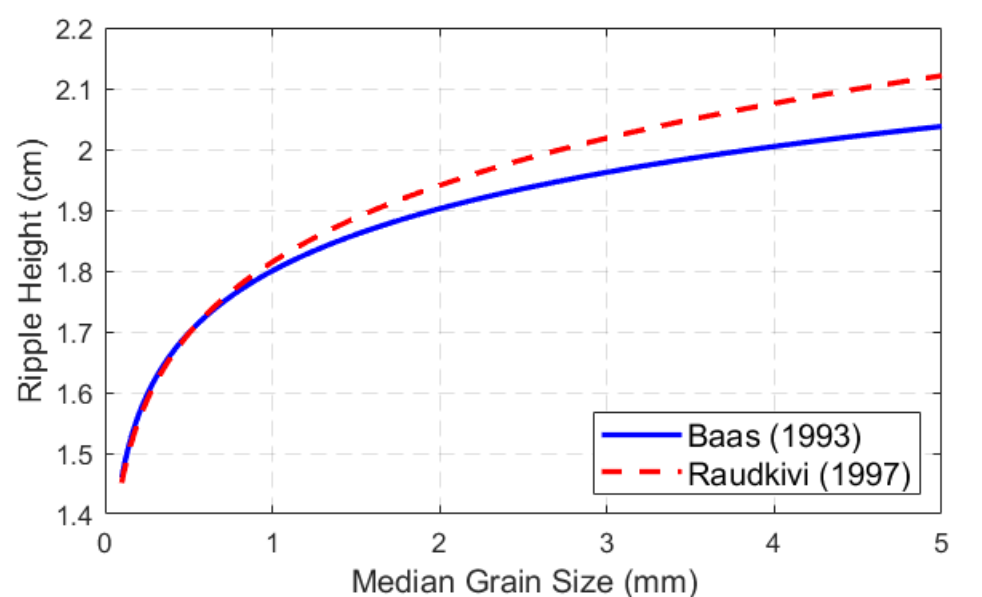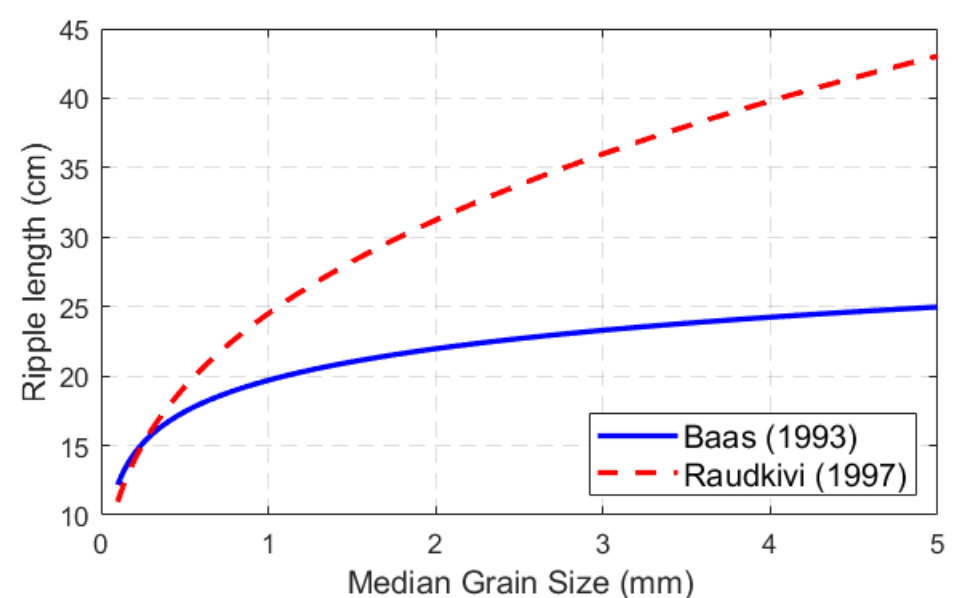Download PDF
Download page Bedform Geometry.
Bedform Geometry
Bedforms are closely related to flow conditions. As the flow strength increases, a stationary flat bed may evolve to form ripples, mega-ripples, dunes, moving planar bed, anti-dunes, and chutes/pools.
Ripples
Ripples are relatively triangular bed features formed by current and wave motion over sandy beds with grain sizes between 0.06 mm and about 0.7-1.0 mm. Observations indicate that ripples are independent of the flow depth.
Current-generated ripples are generally asymmetric and travel downstream. They are characteristic of lower flow regimes with Froude numbers less than 1. The ripple slopes on the lee side are generally close the critical stability slope for sediment. Many formulas are available in literature for calculating current ripples. The formulas included here are:
- Baas (1993)
- Raudkivi (1997)
A comparison of the two ripple geometries is provided in the figures below.

Figure 1. Comparison of ripple height formulas.

Figure 2. Comparison of ripple length formulas.
Before proceeding, it is useful to define the current-related equilibrium and maximum bedform geometries. The equilibrium bedform geometry corresponds to the geometry under steady conditions considering the bed composition (e.g. d_{50} ), flow conditions, and preexisting bedform geometry. Biodegradation is not included in the equilibrium bedform geometry. The maximum bedform geometry corresponds to the maximum ripple height considering only the bed composition and not the flow conditions. Some empirical formulas only provide an estimate of the maximum ripple geometry without consideration of the flow conditions.
Baas (1993)
The following regression equations for the current-related maximum ripple height and length were proposed by Baas (1993)
| 1) | \Delta _{r,\max }=3.4\log _{10}(d_{50}) + 18 |
| 2) | λ_{r, \max} = 75.4\log_{10}(d_{50}) + 197 |
where \Delta _{r, \max } and λ _{r, \max} are the maximum ripple height and length respectively, d50 is the median grain size, and all variables are in mm. Baas (1993) does not provide a method for estimating the equilibrium ripple dimensions.
Raudkivi (1997)
Raudkivi (1997) proposed the following simple dimensional formulas for the current-related maximum ripple height and length
| 3) | \Delta _{r,\max }=0.074\lambda _{\,r,c,\max }{d_{50}}^{-0.253} |
| 4) | λ_{ r, \max} = 245 { d_{50} }^{0.35} |
where \Delta _{r,\max } and λ _{r, \max} are the maximum ripple height and length respectively, d50 is the median grain size, and all variables are in mm. Raudkivi (1997) does not differentiate the equilibrium ripple dimensions from the maximum ripple dimensions. It is noted that the Raudkivi (1997) formula is used by the Wu et al. (2000) sediment transport equations.
Dunes
Dunes are current-generated bedforms which are characteristic of lower regime flows with Froude numbers less than one. There are many formulas for predicting dune geometry. Here the following formulas are included:
- Karim (1995)
- van Rijn (1984)
Karim (1995)
Karim (1995) proposed the following simple relations for the dune height and length:
| 5) | \frac{\Delta _{d,eq}}{h}=\left\{\begin{array}{l} \begin{array}{l} -0.04+0.294\frac{u_{*}}{\omega _{s,50}}+0.00316\left(\frac{u_{*}}{\omega _{s,50}}\right)^{2}\\ -0.0319\left(\frac{u_{*}}{\omega _{s,50}}\right)^{3}+0.00272\left(\frac{u_{*}}{\omega _{s,50}}\right)^{4} \end{array}\,\,\,\,\,\,\mathrm{for}\,\,0.15<\frac{u_{*}}{\omega _{s,50}}<3.64\,\,\mathrm{and}\,\,d_{50}>d_{silt}\\ 0\,\,\,\,\,\,\,\,\,\,\,\,\,\,\,\,\,\,\,\,\,\,\,\,\,\,\,\,\,\,\,\,\,\,\,\,\,\,\,\,\,\,\,\,\,\,\,\,\,\,\,\,\,\,\,\,\,\,\,\,\,\,\,\,\,\,\,\,\,\,\,\,\,\,\,\,\,\,\,\,\,\,\,\,\,\,\text{otherwise} \end{array}\right.\, |
where
{u_{*} = current shear velocity (total) [L/T]
ω_{s, 50} = fall velocity based on the median grain size d50 [L/T]
Karim (1995) does not provide a method for estimating the dune length.
van Rijn (1984)
van Rijn (1984c) formulas for the dune height, \Delta _{d}, and length, λ_d, are given by
| 6) | \Delta _{d,eq}=\left\{\begin{array} 0.11h\left(\frac{d_{50}}{h}\right)^{0.3}\left[1-\exp (-0.5T_{*})\right](25-T_{*})\,\,\text{for }0<T_{*}<25\\ 0\,\,\,\,\,\,\,\,\,\,\,\,\,\,\,\,\,\,\,\,\,\,\,\,\,\,\,\,\,\,\,\,\,\,\,\,\,\,\,\,\,\,\,\,\,\,\,\,\,\,\,\,\,\,\,\,\,\,\,\,\,\,\,\,\,\,\,\,\,\,\,\,\,\,\,\,\,\,\,\,\,\,\,\,\text{otherwise} \end{array}\right. |
| 7) | λ_{d, eq} = 7.3h |
where
T_{*} = \frac{u_{*}^{'2}}{u_{*cr}^{2}}-1 = sediment transport stage parameter [-]
u'_{*}=\frac{U\sqrt{g}}{C'_{h}} = bed skin shear velocity [L/T]
C'_{h} = 18\log _{10}\left(\frac{12h}{k_{s,g}}\right) = Chézy grain roughness coefficient [L1/3/T]
k_{s, g} = 3d_{90} = grain-related roughness [L]
u'_{*cr} = g(s−1)d_{50}θ_{cr} = critical shear velocity shear velocity [L/T]
θ_{cr} = critical Shields parameter [-]
The critical Shields parameter is calculated based on van Rijn (1984a)